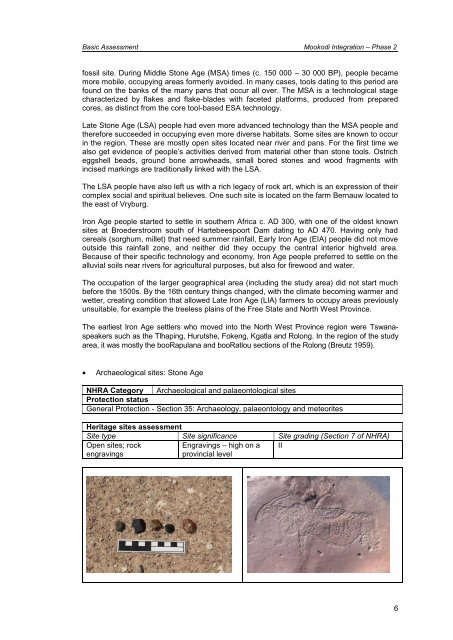A SURVEY OF CULTURAL RESOURCES - SAHRA
A SURVEY OF CULTURAL RESOURCES - SAHRA
A SURVEY OF CULTURAL RESOURCES - SAHRA
You also want an ePaper? Increase the reach of your titles
YUMPU automatically turns print PDFs into web optimized ePapers that Google loves.
Basic Assessment Mookodi Integration – Phase 2fossil site. During Middle Stone Age (MSA) times (c. 150 000 – 30 000 BP), people becamemore mobile, occupying areas formerly avoided. In many cases, tools dating to this period arefound on the banks of the many pans that occur all over. The MSA is a technological stagecharacterized by flakes and flake-blades with faceted platforms, produced from preparedcores, as distinct from the core tool-based ESA technology.Late Stone Age (LSA) people had even more advanced technology than the MSA people andtherefore succeeded in occupying even more diverse habitats. Some sites are known to occurin the region. These are mostly open sites located near river and pans. For the first time wealso get evidence of people’s activities derived from material other than stone tools. Ostricheggshell beads, ground bone arrowheads, small bored stones and wood fragments withincised markings are traditionally linked with the LSA.The LSA people have also left us with a rich legacy of rock art, which is an expression of theircomplex social and spiritual believes. One such site is located on the farm Bernauw located tothe east of Vryburg.Iron Age people started to settle in southern Africa c. AD 300, with one of the oldest knownsites at Broederstroom south of Hartebeespoort Dam dating to AD 470. Having only hadcereals (sorghum, millet) that need summer rainfall, Early Iron Age (EIA) people did not moveoutside this rainfall zone, and neither did they occupy the central interior highveld area.Because of their specific technology and economy, Iron Age people preferred to settle on thealluvial soils near rivers for agricultural purposes, but also for firewood and water.The occupation of the larger geographical area (including the study area) did not start muchbefore the 1500s. By the 16th century things changed, with the climate becoming warmer andwetter, creating condition that allowed Late Iron Age (LIA) farmers to occupy areas previouslyunsuitable, for example the treeless plains of the Free State and North West Province.The earliest Iron Age settlers who moved into the North West Province region were Tswanaspeakerssuch as the Tlhaping, Hurutshe, Fokeng, Kgatla and Rolong. In the region of the studyarea, it was mostly the booRapulana and booRatlou sections of the Rolong (Breutz 1959).Archaeological sites: Stone AgeNHRA Category Archaeological and palaeontological sitesProtection statusGeneral Protection - Section 35: Archaeology, palaeontology and meteoritesHeritage sites assessmentSite type Site significance Site grading (Section 7 of NHRA)Open sites; rockengravingsEngravings – high on aprovincial levelII6
















